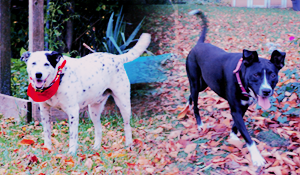I probably forget loads but I do better when I am asked questions rather then trying to come up with things from the top of my head.

History:
originally there were differnt types of sheepdogs for differnt areas, all these dogs were known simpley as "colleys" the breed known today as the "Border Collie" originated in the border regions of scotland and england, the father of the breed is well known, Old Hemp. sheepdogs trials bagan when people started to argue over whos Colleys were the best, so so the trial was created, old Hemp was heads and tails above all the others because he had a unique style, while the rest of the dogs barked, old Hemp used whats known as the "eye" he crouched low and mezmerized the stock with his intense stare, this kepts the sheep calm and moving nicley rather then nervous and jumpy of the barking dogs, and like most legendary dogs he was used at stud..a LOT, so his working style got passed on and improved upon, however they were all over the map with what exactly they were good at, and that is when the even more famous Winston Cap came along, he is considered the father of the modern Border Collie, because rather then onlly being good at certain parts he was amazing at all aspects, Cap single handedly changed the face of the Border Collie, and is in 90% of the pedigrees of todays BCs.
Appearnces:
Border Collies are still primarly a working breed, and as such while there is a generalized look to BCs they come in a huge variety of looks, many of them people have no idea about. the size and build depends on the area, in my area nearly all BCs are small and lightly built, with longs legs and long narrow muzzles, others areas may be different.
Coat-when most people think of a BC they think of a long coat, but in addition to rough coats they also come in smooth(which is the dominant gene) curly coated(not like a poodle but wavy), and wire coated(this comes from Turnbulls blue, a Beardie ROM'd as a BC, and runs through the blood of many BCs)
Colour-most people see black and white right away, this is the classic colouring, however they also come in black tri, red tri, lilic and white, red and white, blue and white, sable, saddleback sable, brindle, blue merle, red merle, and patterned white.
Eyes- eyes are usually brown , but are often blue or green in merles, and can also have black and white with blue eyes.
Ears-pretty much anything goes, in shape they are usually medium medium sized and triangular but the way they are carried anything goes, many breed stanrads say they they are "usually" carried half perked(tipped), I know a lot of BCs and almost every one of them has either fully pricked ears or airplane ears(if the cartiladge did not fold in at one spot they would be fully pricked) they also often have mismatched ears.
Temperment:
the Border collie is considered the smarted breed in the world, and its no wonder, it even owneing BCs it never ceases to amaze me when I here stories bout BCs who have figered out answers to problems that not even I would have been able to come up with, like the one whos owner placed a moutrap on top of the garbage can, so the BC took its east favorite toy, placed it in the mouse trap, removed the trap(attached to the toy) and raided the garbage, as clear in the above story "smart" and "trainable" are very differnt lol BCs live to please there owners but they are also independent thinkers, thye had to be, they were bred to listen to the handlers but they were also bred to be able to think about what the hander said, assess weather or not its the right thing to do, and ignore the handers commands when needed, they needed to be ablke to do this in the blink of an eye, I dont know very many humanes that have the ability to make snap desisions and have it be the RIGHT one lol
Energy:
BCs are known for their energy, however every dog is differnt, and differnt BCs utilize this energy in differnt fashions. for example, Misty is extremly energentic and can go forever, but its because she stops to take 2 minuts power rests before she is worn out, this way she never truly runs out of energy. Happy on the other hand can go for hours, but then she crashes, its because she does not stop, she keeps on going till she collapses, but this means that she sleeps for longer peiods making her seem lazier then Misty, when really they have about equal energy levels.
maybe I should stop now... lol
Originally Posted by cali
I probably forget loads but I do better when I am asked questions rather then trying to come up with things from the top of my head.








 Reply With Quote
Reply With Quote







 )
)



Bookmarks